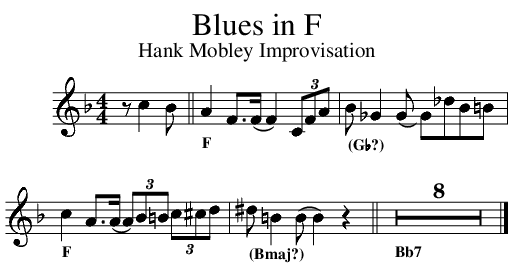
Here is a series of tutorial papers touching on advanced topics
in piano voicing and improvisation. Their overall purpose is to help bridge the
gap between music theory and practice. The papers are independent and
self-contained and are best used to supplement other teaching materials.
Because the individual topics are isolated, rather than elements of a graded set,
they should not be considered as a substitute for a comprehensive or organized jazz method.
Jazz students and performers who can read music proficiently and
have a good understanding of harmony may find them useful. Several of the notes
take examples from recorded performances by world class musicians.
No. 1, Using Whole Tone Scales in Improvisation
This note explains some properties of whole tone scales which simplify their use in major and minor keys. The symmetry of whole tone scales makes the spontaneous creation of repeated motifs especially easy.
Note that the passage over the " C7 " chord could be viewed as a transition from the dominant 7th to its substitute Gb7 . More detailed examples from real-life improvisations along with harmonic analyses can be found by clicking the snippet above.
No. 2, 'Side-slipping' in Improvisation
Side-slipping is a term which refers to an unexpected upward or downward semi-tone shift of a harmonic sequence, a lead voice, or both. It is rather uncommon in improvisation, but does provide a sudden increase in tension which wants to resolve from this neighbor key to the original. This note provides examples of side-slipping in the lead voice, in the underlying harmony and as chord substitution.
Further examples and discussion, downloaded by clicking the shippet above, include examples where the term side-slipping refers to switching to the tritone substitute for the dominant chord or the tonic 7th. Although it isn't necessary to anyalyze this change as side-slipping, its execution is easily viewed as a slip from the tonic or dominant up or down a half step.
No. 3, Diminished Scales in Improvisation
Diminished scales have been a subject of great interest to jazz musicians for decades. Their explicit use is rather uncommon, but some spectacular examples can be found in recorded literature. In the improvised solos of Hank Mobley, for example, are passages which would be difficult to analyze without the concept of diminished scales. Some of them are included in this note, downloadable by clicking the snippet.
No. 4, Rootless Voicings in Piano Improvisation
Jazz piano voicing is one of the most complex and difficult aspects of the art. There are as many variations as there are performers, and it's difficult or impossible to explain them all with a single theory. This first note on the subject attempts to illustrate some of the mechanics of rootless voicings and their application to solos and improvisation. Click on the snippet to download the paper.
No. 5, 'Avoid' Notes in Improvisation
So-called 'avoid' notes provide the creative musician with opportunities to break tentative rules and expand the scope of the art. Needless to say, the notion that certain notes should be avoided in certain situations should never be considered a hard rule. It has been said that Charlie Parker developed some of his innovative style by finding ways to incorporate any note into melodic passages involving any chord. Classical literature also contains many counter-examples to the idea of avoid notes. The full paper can be downloaded by clicking the snippet below.
A Challenge in Harmonic Analysis
In one of Hank Mobley's improvisations on a 12 bar blues in F, he played the following phrase:

"
This short passage is interesting for a number of reasons. It can be analyzed by several distinct harmonic theories. Tri-tone substitutions come to mind, as do instances of side-slipping. In any case, it shows that even with an old jazz song form like the blues, there is still more to be said.